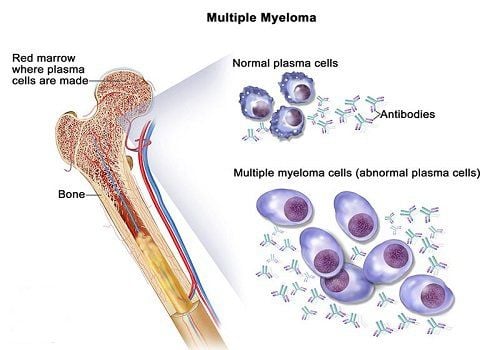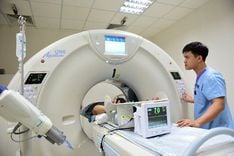This is an automatically translated article.
Article by Master, Doctor Tran Quynh Trang - Doctor of Biochemistry - Laboratory Department - Vinmec Times City International Hospital
Beta 2 microglobulin (β2M) is a low molecular weight (11,800 Dalton) protein present in most nucleated cells of the body and acts as part of the immune system. High levels of β2M in blood and urine signal the disease as well as the prognosis of treatment in cancer patients.
1. What is a beta2 microglobulin test?
Under normal physiological conditions, a small amount of Beta 2 microglobulin (β2M) is secreted by cells into the blood from the cell surface or by intracellular release, especially by B lymphocytes and tumor cells. They are present in most body fluids such as urine, joint fluid, etc., and levels increase when they increase production, destroy cells, or activate the immune system. This test measures β2M in blood, urine, or rarely in cerebrospinal fluid.
Besides, Beta 2 microglobulin (β2M) is also a tumor marker. Tumor markers are substances produced by cancer cells or normal cells in response to cancer. Healthy people have small amounts of Beta 2 microglobulin (β2M) in their blood and urine. In contrast, people with bone marrow cancer, leukemia, lymphoma, leukemia, and multiple myeloma often have high levels of β2M in their blood or urine. High levels of β2M in the cerebrospinal fluid may be a sign that the cancer has spread to the brain and/or spinal cord. Therefore, the β2M test can not only be used to diagnose cancer, but it can also provide important information about the cancer, including its severity and progression.
β2M blood and sometimes urinalysis may be ordered to help the physician determine the severity and stage of multiple myeloma, and to assess the patient's prognosis and effectiveness of the therapy. the treatment.
Accordingly, elevated levels of β2M in the blood correlate with a large number of tumors and decreased renal function in patients with multiple myeloma. Recently, the international myeloma research group published new guidelines called the international staging system for multiple myeloma. The staging system is mainly based on blood levels of both albumin and β2M. Higher blood levels of β2M correspond to higher disease stages and advanced disease with a worse prognosis.
Similarly, B2M may be an early detection biomarker for lung cancer, which is often diagnosed at an advanced stage. B2M levels were higher and more frequent in lung cancer patients.

2. Beta 2 microglobulin (β2M) test
According to a study by Anna E Prizment et al in 2016 on the association between Beta 2 microglobulin (β2M) and colorectal cancer when studied in adult patients followed up for up to 17 years. Participants with the highest serum Beta 2 microglobulin (β2M) levels compared with the lowest group had a 25% higher risk of all types of cancer and a 121% higher risk of colorectal cancer. The mechanisms that explain the association between serum β2M levels and carcinogenesis remain unclear. However, it is possible that β2M plays several roles: angiogenesis, tumor neoplasia,... can promote innate proinflammatory cytokines (eg, TNF-α, interleukin (IL)-1, IL-6 and IL-8) and growth-promoting factors (eg, vascular endothelial growth factor, epidermal growth factor, fatty acid synthesis, insulin, and growth factor-like receptor insulin in both cancer patients and unaffected individuals and may promote epithelial-mesenchymal transition
Conditions associated with increased cell production or destruction, infection Severe infections, viral infections such as CMV (Cytomegalovirus) and certain conditions that trigger the immune system such as inflammation and autoimmune disorders can cause β2M elevation. Monitor kidney disease disorders, help doctors distinguish between glomerular and tubular lesions.The kidneys filter waste products from the blood and reabsorb β2M, so there is normally only a small amount of β2M in the water. if The renal tubules are damaged, β2M is less reabsorbed, so the concentration of β2M increases in the urine. Medications such as the antibiotics lithium, cyclosporine, cisplatin, carboplatin, and aminoglycosides can increase blood and/or urine β2M levels.

3. In what cases is the β2M test indicated?
The β2M test is indicated in the following cases:
Edema of the face, eyelids, ankles or wrists. Diagnosis and monitoring of treatment effectiveness of multiple myeloma. Prognosis in patients with myeloma or lymphoma. There is protein in the urine or urine is foamy, blood. Fatigue, weakness. Nausea. Suspect renal injury to differentiate between glomerular and tubular disorders. Dialysis-associated amyloidosis occurs when blood proteins are deposited in joints and ligaments causing pain, stiffness, and fluid in the joints. Biological values:
60 years old ≤ 3.0 mg/L > 60 years old ≤ 3.0 mg/L This value may vary by method and laboratory.
In summary, Beta 2 microglobulin (β2M) is a low molecular weight (11,800 Dalton) protein present in most nucleated cells of the body and acts as part of the immune system. High levels of β2M in blood and urine signal the disease as well as the prognosis of treatment in cancer patients. Therefore, when ordering this test, the patient should strictly follow the doctor's instructions.
Please dial HOTLINE for more information or register for an appointment HERE. Download MyVinmec app to make appointments faster and to manage your bookings easily.
References:
Nomura T, Huang WC, Zhau HE, Josson S, Mimata H, Chung LW. β2-Microglobulin-mediated signaling as a target for cancer therapy. Anticancer Agents Med Chem. 2014;14:343–352. [PMC free article] [PubMed] [Google Scholar] Karlsson FA, Wibell L, Evrin PE. Beta 2-microglobulin in clinical medicine. Scand J Clin Lab Invest Suppl. 1980;154:27–37. [PubMed] [Google Scholar] Yang J, Qian J, Wezeman M, Wang S, Lin P, Wang M, et al. Targeting beta2-microglobulin for induction of tumor apoptosis in human hematological malignancies. Cancer cells. 2006;10:295–307. [PubMed] [Google Scholar] Rossi D, Fangazio M, De Paoli L, Puma A, Riccomagno P, Pinto V, et al. Beta-2-microglobulin is an independent predictor of progression in asymptomatic multiple myeloma. Cancer. 2010;116:2188–2200. [PubMed] [Google Scholar]














